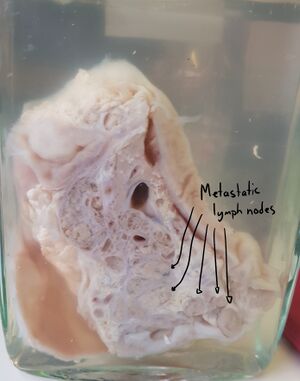4. Exophytic carcinoma of the stomach: Difference between revisions
No edit summary |
No edit summary |
||
| Line 1: | Line 1: | ||
[[File:Exophytic gastric cancer prep front.jpg|thumb|Exophytic gastric cancer prep front]]'''Organ''': Stomach | [[File:Exophytic gastric cancer prep front.jpg|thumb|Exophytic gastric cancer prep front]]'''Organ''': Stomach | ||
'''Description''': | '''Description''': On the front of the preparation can we see a large tumor that protrudes into the lumen of the stomach. On the surface of this tumor is there ulcerated mucosa. | ||
On the front of the preparation can we see a large tumor that protrudes into the lumen of the stomach. On the surface of this tumor is there ulcerated mucosa. | |||
On the back side of the preparation can we see multiple metastatic lymph nodes. Some are whole and some are in cross-section. | On the back side of the preparation can we see multiple metastatic lymph nodes. Some are whole and some are in cross-section. | ||
Revision as of 12:42, 7 July 2024

Organ: Stomach
Description: On the front of the preparation can we see a large tumor that protrudes into the lumen of the stomach. On the surface of this tumor is there ulcerated mucosa.
On the back side of the preparation can we see multiple metastatic lymph nodes. Some are whole and some are in cross-section.
Diagnosis: Fungal type gastric adenocarcinoma
Risk factors:
- Helicobacter pylori
- Alcohol
- Smoking
- Epstein-Barr virus
- Long-standing chronic gastritis
Theory:

Adenocarcinoma accounts for 90% of all cancers in the stomach. It’s very common in Japan for unknown reasons.
There are two ways to classify gastric adenocarcinoma: by macroscopy, which uses the Borrmann classification, and by microscopy, which uses the Lauren classification. The Borrmann classification goes like this:
- Polypoid type – Protrudes into the lumen like a polyp
- Fungative type – Protrudes and has ulcerative surface
- Ulcerative type – Non-protruding with ulcerative surface
- Diffuse growth type – Diffusely thickened gastric wall (linitis plastica)
This preparation is of fungal type. It can also be described as exophytic, which means that it grows out of the epithelium.
The Lauren classification is simpler; it has only two types, intestinal type and diffuse type. The intestinal type has glandular structures. It has a better prognosis than the diffuse type. This type can be classified as high grade or low grade depending on whether the glandular structures show poor differentiation or well differentiation, respectively.
The diffuse type has a special cell type called signet ring cells spread diffusely across the mucosa. These cells have their nuclei compressed on the periphery of the cell, and they have large mucin-containing vacuoles in the cytoplasm. They can be hard to find on biopsy because they’re so diffusely spread. This type is more aggressive and has a worse prognosis than the intestinal type.
